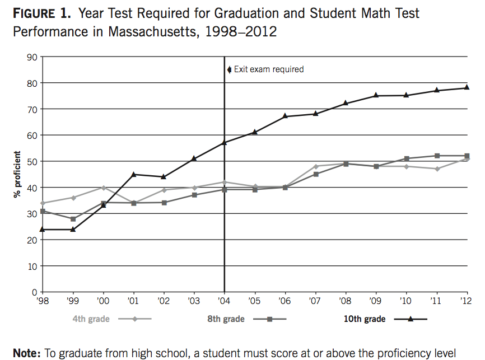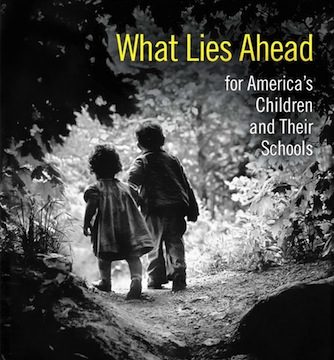The following is an excerpt from What Lies Ahead for America’s Children and Their Schools, a new book edited by Chester E. Finn, Jr., and Richard Sousa for Hoover Institution Press. This excerpt comes from a chapter called “Rethinking Governance” by Paul T. Hill.
 How to fix public education governance in the United States is not a new question. Analysts have suggested many alternative forms of governance, each intended to shift the locus of decision–making from local school boards and state legislatures to other entities, including mayors, parents, and school entrepreneurs.
How to fix public education governance in the United States is not a new question. Analysts have suggested many alternative forms of governance, each intended to shift the locus of decision–making from local school boards and state legislatures to other entities, including mayors, parents, and school entrepreneurs.
Milton Friedman’s book Capitalism and Freedom set off a debate on education governance that continues to this day. He argued for putting parents in charge. John Chubb and Terry Moe suggested a more complex system, with parents in charge but also some roles for regulators, from whom school operators would need to get licenses. [1] Moe has since made a strong case for a mixed system in which government’s role is strictly limited and choice and entrepreneurship are emphasized. [2]
Others have suggested leaving a government-operated school system intact, but putting different people—mayors, [3] appointed boards, or state officials [4]—in charge and using performance standards to focus the attention of educators on student learning, not distracting rules. [5]
Proposals to fix governance by putting mayors or state officials in charge are popular, if poorly thought-through. A change in mode of selection is always a good idea when a governing body is overly politicized or deadlocked. [6]
Takeovers by mayors have overcome the blocking power of unions and district bureaucracies in New York, Hartford, Connecticut, and other cities, but they only work for a while. The same is true of takeovers by special masters or statewide school districts like Louisiana’s Recovery School District. As this is written, the New York and Hartford reforms are both in danger of being thrown out by successor mayors who can gain union support by bashing their predecessors’ policies. The promising state takeover in Oakland, California, has already been abandoned under political pressure. Louisiana’s Recovery District is required by law to return schools to local control.
Mayorally appointed boards and superintendents can run into the same problems as elected ones, particularly if provider groups or political machines control appointments. Appointed boards often confound the expectations of mayors and others who appoint them, just as elected boards can disappoint voters. Any way of selecting board members is open to abuse. When things are not working out well under one method, the grass can look much greener under another.
More fundamental new governance ideas from both sides of the political spectrum also have flaws, from even more open town-meeting style control of schools on the left to total abandonment of governance in preference for market mechanisms on the right.
Unbounded public deliberation about the goals and means of public education would lead to continual and escalating regulation of schools, accelerating the harmful developments of the past thirty years. Each succeeding crisis or emergence of a noble cause would lead to new regulations, to be layered on top of those created earlier.
In an ideal world, well-intentioned regulation driven by community politics would serve to increase equity of access and outcomes. In practice, it leads to precisely the opposite outcome by severing the link between those who know something that might help and those who make the decisions.
Total reliance on the market is also unrealistic. A pure market would allow only parents’ consumer behavior to govern who ran schools, which schools were forced to close, what schools offered in the way of instruction, and thus ultimately what children would learn. While consumer choice would drive improvement, it is likely that, absent government oversight, data-cooking and exclusion of hard-to-educate students by a subset of schools would destabilize the entire arrangement. [7] Our existing legal protections governing discrimination and child protection would lead to court intervention and piecemeal re-regulation of exactly the kind that produced the irrational governance system we have today.
A pure market would in time attract innovators and entrepreneurs with new ideas about how to meet existing and new needs. It would also ultimately teach families the consequences of bad choices—as poorly prepared children could not get needed education or jobs—but nobody knows whether that would take a few years or a few generations. [8] In the meantime, many could suffer, and the pressure for re-regulation would be hard to resist.
Governance changes are tricky. Proposals that assume that some class of actors, if put fully in charge, will naturally seek effective schools for all children are doomed to failure. No one group or entity has exactly the same interest as children, and each can be expected, in the long run, to pull schooling, and the uses of public funds, in directions that meet its own interests.
Paul T. Hill is the John and Marguerite Corbally Professor at the University of Washington Bothell and Director of the Center on Reinventing Public Education, which develops, tests, and helps communities adopt alternative governance systems for public K-12 education.
Reprinted from What Lies Ahead for America’s Children and Their Schools, edited by Chester E. Finn Jr. and Richard Sousa, with the permission of the publisher, Hoover Institution Press. Copyright © 2014 by the Board of Trustees of the Leland Stanford Junior University.
Notes:
1. John Chubb and Terry M. Moe, Politics, Markets, and America’s Schools (Washington, DC: Brookings Institution Press, 1990). 2. Terry M. Moe and Paul T. Hill, “Moving to a Mixed Model: Without an Appropriate Role for the Market, the Education Sector Will Stagnate,” in The Futures of School Reform, ed. Jal Mehta, Robert B. Schwartz, and Frederick M. Hess (Cambridge, MA: Harvard Education Press, 2012). 3. Kenneth K. Wong, Francis X. Shen, Dorothea Anagnostopoulos, and Stacey Rutledge, The Education Mayor: Improving America’s Schools (Washington, DC: Georgetown University Press, 2007). See also Kenneth K. Wong, “Measuring the Effectiveness of Mayoral Takeover as a School Reform Strategy,” Peabody Journal of Education 78, no. 4 (2003): 89–119. 4. Chester E. Finn Jr., “Reinventing Local Control,” Education Week, January 23, 1991, 40. 5. Jennifer A. O’Day and Marshall S. Smith, “Systemic Reform and Educational Opportunity,” in Designing Coherent Education Policy: Improving the System, ed. Susan H. Fuhrman (San Francisco: Jossey-Bass, 1993), 250–312. 6. Ashley Jochim and Paul T. Hill, “Mayoral Intervention: Right for Seattle Schools?” (Seattle: Center on Reinventing Public Education, 2008). 7. Cases brought by parents of handicapped children already threaten re-regulation of the all-charter New Orleans public school system. 8. On the time dimension in implementation of choice, see a recent Hoover Institution Press book by the present author, Learning as We Go: Why School Choice is Worth the Wait (2010).




